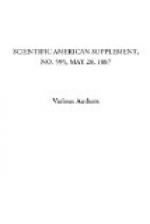It has often been said that every engineer on his arrival in India sets about improving this useful apparatus; but if we may judge from the endless variety of forms which may be seen in shops and offices, in public and in private buildings, no general principle of construction has been recognized, and the punka, as we see it, seems to depend, for its form, more upon the taste of the workman who makes it than on anything else.
We shall begin by directing our attention to the suspended punka, which is usually hung from the ceiling, and put in movement by a cord. The object of this class of punka is to produce a downward current of air by swinging to and fro, and the best punka is the one which throws downward the greatest quantity of air with the smallest applied force.
The swinging punka is one of the simplest forms of mechanism; it can be fitted up with the most primitive materials, and however badly made, it will always have some effect. This fact has its good and its bad aspects; it brings a certain comfort within the reach of all, but it removes a great part of that necessity which, as we all know, is the mother of invention.
There are some very important natural laws which are illustrated in the punka. The first is that which governs the movement of the pendulum. The number of swings it makes per minute depends on the length of the suspending cords; a pendulum three feet long will swing 621/2 times per minute, and a pendulum six feet long will swing 441/4 times per minute. Whether the swings are long ones or short ones, the number per minute is still the same. You cannot, therefore, alter the natural rate of movement of a punka unless you pull it at both sides.
The next law is that which determines that the angles of incidence and of reflection are equal. This in simple language means that it is useless to expect a good downward current of air from a slow moving and heavy punka, with long suspending cords which keep it nearly always in a vertical position to its plane of movement. Striking the air squarely as it does in its forward and backward movement, it throws almost as much air upward as downward, and of course all the air that is propelled in any other than a downward direction represents just so much power wasted.
One more law, and then we may proceed to demonstration.
As the air weighs 0.072 lb. per cubic foot at 82 deg. Fahrenheit, and as a considerable quantity of air is put in motion, the power required to drive a punka depends upon the quantity of air it puts in motion in a given time.
The useful effect is a separate matter; it depends on the amount of air thrown in a downward direction.
To summarize; all punkas of the same size or surface, and going at the same speed, require the same amount of pulling. The best one is that which will throw down more air than any other of the same size.
To obtain the greatest result from the power expended in driving it, the punka should be placed as near as possible to the person to be cooled, as the loss of effect, due to distance, increases not in direct ratio, but in proportion to the square of the distance between punka and person. If at two feet of distance he receives one eighth of the total effect, he will at four feet of distance obtain only one thirty-second part.




